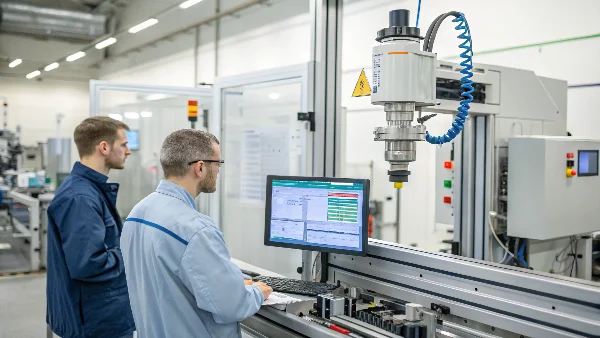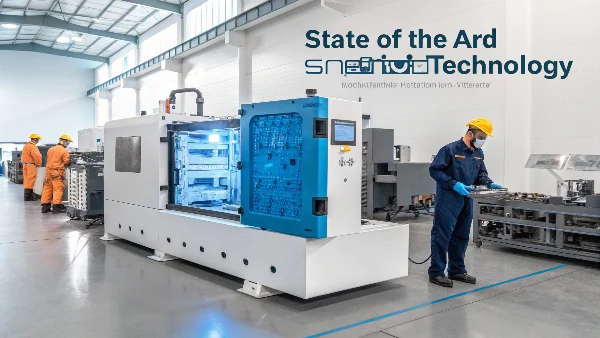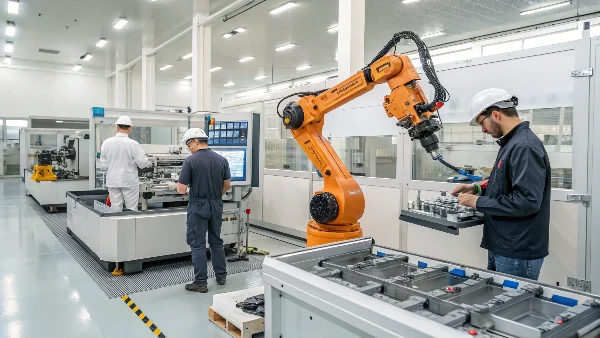Struggling with inconsistent part quality or limited by what your current molding setup can achieve? Old tech often means fighting defects and missing out on complex, high-precision opportunities.
Modern injection molding equipment leverages electric drives, advanced sensors, intelligent software, and automation to deliver unprecedented precision, repeatability, and efficiency, smashing old barriers.
I tell ya, sometimes I walk through our CAVITYMOLD facility, look at our newer machines humming along, and I just gotta shake my head in amazement. It wasn’t that long ago that achieving the kind of tolerances Alex needs for his electronics components felt like wrestling a bear. You’d tweak one thing, and two other things would go haywire! But the technology we have access to today? It’s a whole different ball game. This evolution isn’t just about fancy bells and whistles; it’s about fundamentally changing what’s possible in precision molding. Let’s take a peek at how we got from there to here.
Are Old-School Machines Holding Back Your Precision Parts?
Are you finding that older hydraulic injection molding machines just can’t deliver the shot-to-shot consistency your precision components demand? This often leads to higher scrap rates and constant firefighting.
Traditional hydraulic machines, while robust, often suffer from slower response times, less precise control over injection parameters, and greater process variability compared to modern electric or hybrid systems.
Dive deeper Paragraph:
Look, I don’t want to completely bash the old workhorses – those big, hydraulic machines. For a long, long time, they were the backbone of the industry, and for certain applications, especially very large parts where sheer clamp force is king, they still have their place. I cut my teeth on those machines, learned the fundamentals, and they were built like tanks, that’s for sure! But when we started getting more and more requests for really tiny, intricate parts with hair-splitting tolerances, like the stuff Alex designs for consumer electronics, the limitations of purely hydraulic systems became pretty darn obvious.
The main headaches we faced were:
- Response Time: Hydraulic valves and pumps just can’t react as quickly as electric servo motors. When you need to switch from fill to pack exactly at the right micro-moment, or profile your injection speed with super fine control, hydraulics can lag a bit. That lag might seem tiny, but it can be the difference between a perfect part and a sink mark.
- Precision & Repeatability: Because of that response time and the nature of fluid dynamics (oil temperature changes viscosity, etc.), achieving true shot-to-shot consistency was a constant battle. We’d get a process dialed in, and then an hour later, things would drift. For a high-volume run of precision parts, that drift is a killer.
- Energy Consumption: Let’s be honest, those old hydraulic pumps ran pretty much constantly, even when the machine was idle between cycles. They were energy hogs! Our electricity bill used to make my eyes water.
- Noise & Cleanliness: Hydraulic machines are generally louder and, well, there’s always the risk of oil leaks. Not ideal for a cleanroom environment or if you value your hearing.
I remember one particular project for a medical device component. It was a small, clear polycarbonate part, and the client was absolutely fanatical about dimensional stability and zero flash. We were running it on one of our older hydraulic presses, and it felt like we had an engineer babysitting that machine 24/7, constantly tweaking pressures and speeds. The scrap rate was… uncomfortable. It really highlighted that for the future of precision at CAVITYMOLD, we needed to embrace newer tech.How Have Electric Machines Revolutionized Injection Molding Accuracy?
Tired of process inconsistencies and high energy bills from older hydraulic presses? Achieving the tightest tolerances seems like a constant struggle, impacting your bottom line and lead times.
All-electric injection molding machines, using servo-electric motors for all major movements, offer superior precision, repeatability, speed, energy efficiency, and quieter operation compared to hydraulic counterparts.
Dive deeper Paragraph:
Then came the all-electric machines, and boy, did they change the game for precision molding! It was like going from a classic muscle car to a finely tuned Japanese sports car. Suddenly, we had a level of control that was just a dream with the older hydraulic systems. At CAVITYMOLD, our first all-electric machine was a revelation, especially for the kind of high-tolerance, often thin-walled parts Alex needs for his electronic gadgets.
The magic of all-electric machines lies in their use of high-precision servo-electric motors to drive all the main machine movements: injection, plasticizing (screw rotation), clamping, and ejection. What does this mean in practical terms for us and for customers like Alex?
- Unbelievable Precision and Repeatability: Because servo motors are digitally controlled, their movements are incredibly precise and, crucially, repeatable. Shot after shot after shot, the machine does exactly the same thing. This means injection speeds, pressures, and switchover points are hit with military precision. For parts where a few microns matter, this is gold. We saw our process variation drop like a stone.
- Faster Response Times: Electric motors react almost instantaneously. There’s no hydraulic lag. This allows for much more dynamic and precise control over things like injection speed profiling – starting slow, ramping up, then slowing down again, all perfectly controlled.
- Energy Efficiency: This was a big one! Electric motors only draw significant power when they’re actually doing work. During cooling time or idle periods, energy consumption plummets. Our energy bills actually went down even as we were producing more complex parts. I remember showing the first month’s energy savings to the boss – he nearly fell off his chair!
- Cleaner and Quieter Operation: No hydraulic oil means no leaks, making them ideal for medical or food-grade applications. And they are significantly quieter, which makes the shop floor a much more pleasant place to work. Our operators definitely appreciated that.
-
Parallel Movements: Many all-electric machines can perform certain movements simultaneously (e.g., plasticizing while the mold is opening/closing), which can shave precious seconds off the cycle time. Shorter cycle times mean more parts per hour, which helps keep costs competitive for Alex.
Here’s a quick comparison:Feature Hydraulic Machines All-Electric Machines Precision Good Excellent Repeatability Fair to Good Excellent Response Time Slower Very Fast Energy Use High Low to Moderate Noise Louder Quieter Cleanliness Potential for oil leaks Very Clean Initial Cost Lower Higher Maintenance More (oil, filters) Less (fewer moving parts) For us, the slightly higher initial investment in all-electric machines has paid for itself many times over in terms of improved quality, reduced scrap, lower energy costs, and the ability to take on more challenging precision projects. They are a cornerstone of our "Master Molding Right" philosophy.
What Role Does Advanced Sensor Technology Play in Modern Molding?
Are you often flying blind, only discovering part defects after they’re made? This reactive approach is costly and inefficient, especially when dealing with high-value precision components.
Advanced sensors integrated into both the molding machine and the mold itself provide real-time data on critical process variables like temperature, pressure, and flow, enabling closed-loop control and predictive quality assurance.

Dive deeper Paragraph:
If all-electric machines gave us the muscle and finesse, then advanced sensor technology gave us the eyes and ears – and even a bit of a brain – for the molding process. It’s one thing to tell a machine to do something with precision; it’s another to actually know what’s happening in real-time, especially inside that closed steel mold where all the magic (and sometimes the mischief) happens. This is where modern sensors have become absolute game-changers for us at CAVITYMOLD.
Think about it – in the old days, we were often making adjustments based on the quality of the parts coming out after the fact. It was a bit like driving by looking only in the rearview mirror. Today, we can get a flood of data during each cycle.
Here’s what we’re talking about:
- Machine Sensors: Modern machines are bristling with sensors measuring things like:
- Screw Position and Speed: Essential for precise shot control and plasticizing.
- Nozzle Temperature & Barrel Zone Temperatures: Ensuring the melt is at the perfect, consistent temperature.
- Hydraulic Pressure (on hybrids) or Motor Torque (on electrics): Directly relates to injection and packing pressures.
- Clamp Force: Verifying the mold is held shut correctly.
- Mold Temperature Sensors: Monitoring the temperature of the cooling/heating fluid going in and out of the mold.
- In-Mold Sensors: This is where things get really interesting for precision. We can actually embed sensors directly into the mold cavity or runners!
- Cavity Pressure Sensors: These are tiny sensors that measure the actual plastic pressure inside the mold at specific locations during filling, packing, and cooling. This data is incredibly valuable. It can tell us if the cavity filled completely, how effective the packing phase was, and can even be used to detect variations that might lead to defects before the part is even ejected. I’ve seen these sensors help us pinpoint the root cause of subtle warpage issues that were driving us crazy.
- Cavity Temperature Sensors: Similar to pressure sensors, these measure the plastic temperature inside the mold. This helps verify melt conditions and cooling effectiveness.
What do we do with all this data?- Real-Time Process Monitoring: We can see graphs and trends of critical parameters for every single shot. If something starts to drift, an alarm can go off, or the machine might even make automatic micro-adjustments (closed-loop control).
- Quality Control & Traceability: For critical parts, like those Alex often needs, we can save the process data for every part produced. If a problem is found later, we can go back and see exactly what the process conditions were for that specific batch.
- Process Optimization & Troubleshooting: When trying to dial in a new mold or solve a tricky defect, this data is invaluable. It takes a lot of the guesswork out. For instance, if we see a drop in cavity pressure at the end of fill on a particular shot, we know we might have a short shot or a sink mark developing.
This move towards data-driven molding, enabled by better sensors, is a huge leap. It helps us understand the process at a much deeper level, making us more proactive and less reactive. It’s like having a highly skilled technician watching every single cycle, 24/7.Is "Smart" Mold Technology the Future of Defect-Free Production?
Are you still treating your molds as just passive blocks of steel? This overlooks huge potential for integrating intelligence directly at the point of part formation, limiting your process control.
"Smart" molds integrate sensors, advanced conformal cooling, and sometimes even actuators to actively monitor and control conditions within the cavity, leading to higher quality, faster cycles, and reduced defects.

Dive deeper Paragraph:
Now, building on the idea of in-mold sensors, the concept of the "smart mold" takes things even further. This is where the mold itself stops being just a passive (though precisely machined) tool and starts becoming an active participant in the quality control and optimization process. At CAVITYMOLD, we’re always looking at these emerging technologies because for the ultra-precision, high-value parts that people like Alex need, every little bit of an edge counts. It’s an exciting frontier!
So, what makes a mold "smart"? It’s not one single thing, but rather a combination of advanced features working together:
- Integrated Sensor Networks: We’re not just talking one or two cavity pressure sensors anymore. Imagine a network of sensors—pressure, temperature, maybe even flow front sensors—strategically placed throughout the mold cavities and runner system. This gives an incredibly detailed, real-time map of what’s happening with the plastic as it flows, packs, and cools.
- Conformal Cooling (and Heating): This is a big one. Traditional mold cooling channels are usually straight-drilled lines, which means some areas of the part (especially complex geometries) might cool slower or faster than others. Uneven cooling is a major cause of warpage and long cycle times. Conformal cooling channels are designed to follow the exact contours of the part, often using metal additive manufacturing (3D printing in metal) to create these intricate pathways. This means much more uniform and efficient cooling, leading to:
- Shorter cycle times (sometimes dramatically so!).
- Reduced warpage and internal stresses.
- Better dimensional stability.
I recall a project with a very tricky, deep-draw part that was prone to warping. Retrofitting the mold with conformal cooling inserts made a night-and-day difference. The cycle time dropped by nearly 20%, and the warpage virtually disappeared. Alex was thrilled!
- Intelligent Venting: Some smart mold concepts include dynamically controlled vents that can open or close based on sensor feedback to optimize air evacuation and prevent gas traps or burns.
- Localized Heating/Cooling Elements: Imagine tiny heating elements near gates to prevent premature freeze-off or specific cooling pins in hot spots, all actively controlled.
- Data Logging and Communication: The mold itself can log its own "experiences"—number of cycles, maintenance history, sensor data—and communicate this to the molding machine or a central plant system (Industry 4.0 stuff!).
The idea is to have the mold almost self-regulating, or at least providing incredibly rich data to allow the machine or operator to make highly informed adjustments. It means moving from hoping for good parts to engineering good parts with a much higher degree of certainty. While not every mold needs to be this "smart," for those ultra-critical, high-volume, or problematic parts, the investment can pay off big time in reduced scrap, faster production, and consistently higher quality. It’s another step towards mastering molding right, right at the source!How Is Automation and Robotics Streamlining Precision Molding Operations?
Is manual part handling, inspection, or secondary operations creating bottlenecks, inconsistencies, or increasing labor costs in your precision molding setup? This can erode your competitive edge.
Automation, including robotics, streamlines precision molding by consistently handling part removal, inspection, sorting, and downstream processes, improving efficiency, quality, and enabling lights-out operation.

Dive deeper Paragraph:
The evolution of injection molding equipment isn’t just about the press itself; it’s also about everything around the press. And that’s where automation and robotics have become incredibly important, especially when we’re aiming for the kind of consistent, high-quality output that precision molding demands. At CAVITYMOLD, integrating automation has been key to improving efficiency and ensuring that the parts Alex receives are perfect, every single time.
Think about what happens once that mold opens and the part is ejected. In the old days, an operator would manually remove the part (and runner, if it was a cold runner system), visually inspect it, maybe trim some flash, and then place it in a box. This process, while straightforward, has a few inherent challenges for precision work:
- Consistency: Humans, bless our hearts, are not robots. The way one operator handles a part might be slightly different from another. This can introduce variability, especially with delicate or still-warm parts.
- Cycle Time Impact: Manual intervention can add variability to the overall cycle time.
- Ergonomics & Safety: Repetitive tasks can lead to strain, and reaching into machines always carries some risk.
- Labor Costs: Dedicated operators for simple tasks add to the cost per part.
Enter robotics and automation! Here’s how they’re making a difference:- Automated Part Removal: Robots (often 3-axis or 6-axis) are commonly used to precisely and gently remove parts (and runners) from the mold as soon as it opens. They do it the exact same way, every single cycle. This is crucial for:
- Maintaining consistent cycle times.
- Preventing damage to delicate parts.
- Enabling "lights-out" or unattended operation for periods.
- Downstream Operations: Once removed, the robot can place the part into:
- Inspection Stations: Integrated vision systems can automatically inspect parts for defects, dimensions, or flash far more reliably and quickly than the human eye for certain features.
- Degating Stations: Robots can present parts to automatic degaters that cleanly remove the runner.
- Assembly Lines: Parts can be directly fed into an automated assembly process.
- Cooling Fixtures or Conveyors: For parts that need controlled post-mold cooling to maintain dimensional stability.
- Packaging Systems: Stacking, boxing, or palletizing finished goods.
- Mold Maintenance & Quick Changeovers: Robots can even assist with mold spraying (applying release agents) or in some advanced setups, even help with aspects of mold changes, reducing downtime.
I remember when we installed our first integrated robot and vision system for a high-volume job for Alex. It was a small, complex component that required 100% inspection. The robot would demold the parts, present them to a camera, and then sort them into "good" and "reject" bins. The consistency was phenomenal, and it freed up an operator to focus on more value-added tasks. It’s not about replacing people, but about elevating what people do and letting the robots handle the repetitive, precise, or potentially hazardous tasks. This level of automation is really a hallmark of modern, efficient, precision molding.Conclusion
The evolution of injection molding equipment—from smart electric machines and advanced sensors to intelligent molds and robotics—has truly revolutionized precision, efficiency, and our ability to tackle complex challenges.
- Automated Part Removal: Robots (often 3-axis or 6-axis) are commonly used to precisely and gently remove parts (and runners) from the mold as soon as it opens. They do it the exact same way, every single cycle. This is crucial for:
